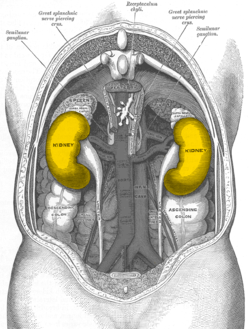The kidneys are paired organs with several functions. They are seen in many types of animals, including vertebrates and some invertebrates. They are an essential part of the urinary system and also serve homeostatic functions such as the regulation of electrolytes, maintenance of acid-base balance, and regulation of blood pressure. In producing urine, the kidneys excrete wastes such as urea and ammonium; the kidneys also are responsible for the reabsorption of water, glucose, and amino acids. The kidneys also produce hormones including calcitriol, renin, and erythropoietin.
Located behind the abdominal cavity in the retroperitoneum, the kidneys receive blood from the paired renal arteries, and drain into the paired renal veins. Each kidney excretes urine into a ureter, itself a paired structure that empties into the urinary bladder.
Renal physiology is the study of kidney function, while nephrology is the medical specialty concerned with kidney diseases. Diseases of the kidney are diverse, but individuals with kidney disease frequently display characteristic clinical features. Common clinical conditions involving the kidney include the nephritic and nephrotic syndromes, renal cysts, acute kidney injury, chronic kidney disease, urinary tract infection, nephrolithiasis, and urinary tract obstruction.[1] Various cancers of the kidney exist; the most common adult renal cancer is renal cell carcinoma. Cancers, cysts, and some other renal conditions can be managed with removal of the kidney, or nephrectomy. When renal function, measured by glomerular filtration rate, is persistently poor, dialysis and kidney transplantation may be treatment options.
| Latin = ren | |
|---|---|
 | |
| Human kidneys viewed from behind with spine removed | |
 | |
| Lamb kidneys | |
| Gray's | subject #253 1215 |
| Artery | renal artery |
| Vein | renal vein |
| Nerve | renal plexus |
| MeSH | Kidney |
| Dorlands/Elsevier | Kidney |



0 comments:
Post a Comment